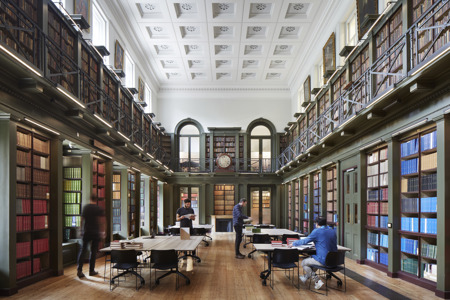

Royal College of Surgeons of England
Hawkins\Brown
Client: Royal College of Surgeons of EnglandCost Consultant: ArteliaServices & Structural, acoustics, fire and facade Engineer: AECOMPlanning Consultant: Gerald Eve, Graham OliverProject Manager: Lend LeaseProject manager for museum fit out: Fraser Randall, Louise RushHeritage Consultant: Montagu EvansMuseum Specialist: Casson MannLandscape Architects: B|D landscape architectsInclusive Design Consultants: Lord ConsultantsContractor: Wates Construction
The transformation of the Royal College of Surgeons isn’t simply the new building. It’s a cultural and institutional shift to more modern, flexible, new ways of working. Open plan, flexible ‘activity based’ workspaces, with centrally shared social and informal meeting spaces, are arranged around the central atrium at upper levels.
Chance encounters and impromptu meetings encourage the exchange of ideas between visiting surgeons, researchers, and staff. Through the global pandemic in 2020 the brief continued to develop, requiring space and furniture to accommodate a more agile workforce with a variety of workspace requirements and flexibility. Modular furniture, storage solutions and ‘touch down’ space in an open plan layout are supported by bookable high-tech meeting rooms, tea points and social spaces.
The interiors strategy celebrates the threshold between the new and old across all levels with subtle differences in colour of both fixed joinery and loose furniture. Warm gallery lighting within the atrium highlights the texture of the original brickwork facade.
Lime wash, lime paint and lime render have been applied to the surface to visually homogenise and brighten its appearance, whilst allowing its texture and layers of history to shine through, warts and all.
Step-free connections between new and old are achieved via sloped floors, helping overcome historic issues of accessibility and circulation. The new frame pulls back on each level to give the original brick facade space to breath and to be celebrated. This wall sails through every level of the atrium as a reminder of the historic building, and its relationship with the new.
Generous circulation around the atrium perimeter incorporates seating and workspaces to permit touch-down working and informal collaboration. Allowing staff to be flexible in their work modes and to benefit from the daylight flooding in from the barrel vaulted rooflight above.